Greece By Kai
When I think of Greece, the first thing that comes to mind is Rick Riordan’s series, Percy Jackson. Unfortunately, no gods showed up to tell me I’m a demigod in disguise, but I’m sure there’s a reason they’re taking their time. Despite that slight disappointment, Greece lived up to its reputation.
We were picked up from the airport by a taxi who drove us to the apartment we’d rented in Athens. It had three bedrooms, one with twin beds for us, another for our parents, and one more for our grandparents. We were just below the Acropolis, and had a clear view of Zeus’s Garden and temple from the small dining room. Once we dropped off our suitcases, we headed out into the city to see Greece for the first time (At least for my sister and I- my parents and grandparents had been before).
We decide to go to the head government building in Greece, the place their congress met. We were walking towards it, when we we were passed by an entourage of four military officers, three in traditional Greek outfits, complete with tassels and pom-poms. We hurried after them, to watch the changing of the guard. They moved like robots, in perfect unison, stomping and turning exactly together. Once they were in place, they stared straight ahead and didn’t move, despite the pictures being taken, and bright sun in their eyes- a lot like the American soldiers guarding the tomb of the unknown soldier. It seemed almost disrespectful to take a picture of men so dedicated to their country, treating them like any ruin or interesting monument in Greece. Of course, we wouldn’t do such a thing!.
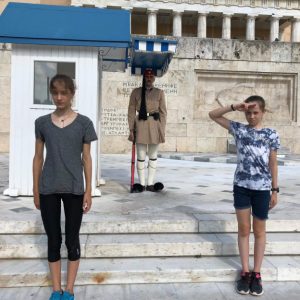
As we were preparing to leave, a group of about 5 people entered the plaza outside the government building, with posters and a megaphone. For over and hour, we watched them protest the Greek government’s ruling on a refugee from Turkey. Turgut Kaya was a “revolutionary” in Turkey, who opposed the government. He escaped Turkey into Greece, seeking political asylum. The Turkish government sent out an Interpol alert, saying that whoever found Kaya had to return him to Turkey to receive punishment, which was almost certainly death or torture. The Greek government arrested him, and he was thrown in jail to await the Supreme Court’s decision. They ruled against him, and he’s been protesting by fasting for over 60 days now. The group in the plaza shouted and chanted at the Greek government, and was still there when we left. You’d think the people who invented democracy wouldn’t have anymore problems with it, but apparently not! 🙂
The day after the protest, we walked up the Acropolis with a tour guide. Halfway up the mountain, she stopped at the first theater, and explained about the role of the theater in Ancient Greece. It started when one of the leaders of the Dionysus cult, Thespis, asked the crowd a question about Dionysus that he already knew at a religious ceremony. The year after, he asked a few more questions, and started a tradition. He was called the first hypocrite, and the first actor. The Greek theaters grew from this point, becoming a major part of Greek life.
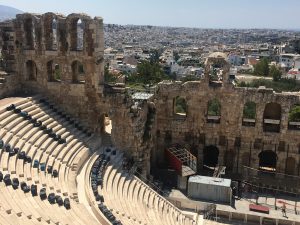
The theater wasn’t merely for pleasure, though. The ancient Greek doctors believed that ½ of the process of healing was of the body (the physical mending of bones, wounds healing, ect.), but you could not heal physically if the mind and spirit were not in balance. One way to balance the mind was through the pleasure of the stage, and so sick patients would be given free access to the nightly shows. Because of this, the first Greek hospital is meters away from the theater. The idea of a balanced mind is not only reflected in medical work, but also in art. All the sculptures portraying the gods have completely calm expressions. Even in battle, the gods’ faces aren’t twisted in rage or sorrow, but totally placid. Since the gods are perfect, this represented how their mind was never unbalanced, how they didn’t submit to bouts of emotion based on things that will pass.
Some of the best examples of this are in the Parthenon, the biggest structure the ancient Greeks ever made.
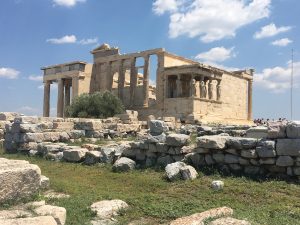
The Parthenon was built to the patron goddess of Athens, Athena. Legend tells us that Poseidon and Athena were at war with each other, each wanting patronage of the capital city. Zeus ended their fight by suggesting that each gave the city a gift, and the people of Athens could vote on the better gift, the god of which would be patron. Poseidon struck the ground with his trident, and a spring of saltwater sprang from the ground. There is still a hole is the roof and ground of the Parthenon where the Greeks said the spring was. Poseidon also gave them horses, these two gifts representing great power in battle on both land and sea. Athena gave Athens the first olive tree and taught them to grow it. She said that the future Athenians would rarely have to fight, being able to trade the goods of the olive tree with other nations to survive instead. Athens chose Athena, and even now the olive branch is a sign of peace.
What makes the temple great, though, is the construction of it. The Greeks were smarter than Columbus, and knew the Earth was spherical, not flat, and that the ships who vanished from sight were just far away and hadn’t fallen off the edge of the earth. They knew that nothing in nature was truly straight and decided to make the Parthenon without straight lines. The base of the structure looks flat, but is actually imperceptibly curved, so that if you’re were on the west side, you can’t see the east side. The columns look straight, but actually start big at the bottom, and narrow towards the top in order to make them seem even taller than they actually are. The columns are also not one big block of marble, but little pieces stacked on top of each other, just like the spine so that, like the spine, it can be flexible instead of falling down in earth quakes. The inside of the Parthenon was as beautiful and ingenious as the outside, with detailed statues lining the room. You can tell whether a statue is Greek or Roman by looking at the back, and at supports. The back of Greek statues are as perfect as the front, while Roman statues often have very minimal detail there. Roman statues also need supports, while Greeks mastered the relaxed pose, without supports necessary. Unfortunately, much of the art was stolen by a British collector a long time ago, and sold to the British museum. The British refused to give them back, saying that the modern Greek people didn’t have enough room in their museum. The Greeks built a brand new museum, complete with spots for the missing pieces. The British are still fighting them, saying why transfer the pieces when they’re already in a museum? The Greeks’ argument is that they built a whole new museum just so that they could have them, and they ask the British to please get their excuses straight before they build a new museum and transfer centuries-old precious artifacts into it for nothing. Currently, the Greek archeological teams aren’t on the best terms with the British.
Once we finished our tour, we went to dinner at one of the best Indian restaurants I’ve ever been to. What was so good about this restaurant? Its food was actually bland enough for my incredibly wimpy American pallet to handle! It seems the Greeks are on the same page as me, concerning spices.
The day after the Acropolis and museum, we went to an amazing country club two minutes away. We could see the Acropolis clearly from where we were, and the Parthenon on top. Definitely the best view I’ve ever had from the courts. Except for the New York skyline. And Costa Rican rainforest. But other than it was the best. Except for the view of the French alps in Maribel. And the- you know what? It was rivaling a couple other views for the best.
The next day, we walked to the Athens Archeological museum, to view art from the cultures the ancient Greeks would have considered ancient. Little doll-like simple figures lined the walls in various positions. Not to offend the archeologists who wrote the plaques describing them, but they were more than a little boring. Not only that, but they were pretty obviously wrong about a few of them.
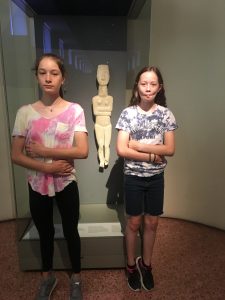
This picture obviously shows the Cycladic (ancient, ancient, ancient Greeks) people had extreme problems with digestion, and experienced near-constant stomach aches. The archeologists think this was meant to be placed over Cycladic graves, but that’s obviously fake news. The absence of the eyes and mouth (as Zosia is trying to imitate by making her mouth as small as possible) is clearly an expression of pain.
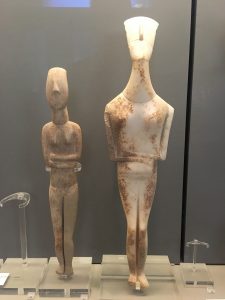
Above is another clear misinterpretation of Cycladic art. The people who have studied them believe this was another example of cemetery art (Left), and somebody gazing at the sky (Right). Any experienced eye can easily tell this is a weak interpretation of the positions of the statues, though. The correct theory is one slightly more violent. Any true expert such as myself can tell that this is a sequence, representing the stages of vomiting. The first one shows somebody clutching their stomach, and the second portrays a person tipping their head back, while the third statue was left to the imagination. Throwing up was probably considered holy, to a people with such constant stomach difficulties.
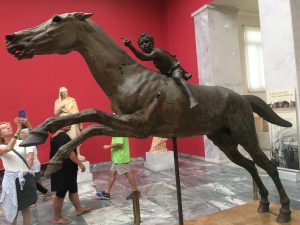
Finally, perhaps the historian’s most obvious mistake, occurs several centuries later, late bronze age. the early Greek people’s pain had to have an outlet also, and as today’s teens know, rude gestures can be a effective one. The archeologists glaze over this early form of “the middle finger”, as it is known today, saying that this boy was a jockey holding reins, but the common passerby can see it wasn’t so innocent…
Over all, the museum was ok, but given the blaring errors in the “professional archeologists” work and the overall lack of ability to hold my sister’s and my interest, you can see why we weren’t exactly sad to leave, especially when ice cream on the way back was put into the equation.
The day after, we left Athens on a Ferry to the island hydra for a few days before leaving Greece for good. In Hydra, we rented a beautiful house with a tiny pool on the ground floor, and a stunning view from the deck upstairs (still traveling with grandparents = still enjoying unnecessary luxuries like incredible houses). The first day, we discovered a small, rocky beach with water so clear you wouldn’t have known it was there if it weren’t for the little waves lapping against the shore. Hydra weather + Hydra beach + perfect-temperature Hydra ocean = heaven. Enough said.
The second day, we went on a hike to a monastery at the top of a mountain. Between the ocean that redefined the color blue, and the miniscule red and white houses, the view from the top was indescribable. Add a huge, adorable, sweet dog who “guarded” the monastery and loved the sandwiches we ate at the peak, and I was seriously thinking about becoming a nun, just so I could live there.
The third day arrived to find us running to a different beach than we went to the first day. The beach wasn’t much different than the one near us -same incredible Hydra water-, but we couldn’t resist running into the waves, despite our complaints the jog there made us too tired to swim. A few hours later, we went back to the first beach, where our grandparents had come in the time we spent at the other one. We wrapped our beach day up with a quick dip in the pool, followed by ice cream (why not?) and a game of hearts (turns out my nuclear physicist/lawyer of a grandfather is really smart, and can count cards. Long story short, Papa won and everyone else suffered a brutal loss.).
Sadly, the day of departure arrived, and we took the ferry back to Athens, having an amazing dinner in the shadow of the Acropolis, followed by a very sad goodbye to our grandparents. We stayed the night at Rea’s Guest House, where we were greeted by the owners of the Airbnb and driven to the airport by the father in the morning (five in the morning to be exact. Morning Kai is not a good Kai. Before-10:00-Kai is REALLY not a good Kai.). We sped through security and said our last goodbyes to western civilization. Egypt, here we come! :0 🙂
Such amazing insights into the history, the beauty and the lure of Greece. Gramps says, “This is a wonderful read and brings back my studies of the origen and development of human culture. With your learning about Greek art, culture and mythology, hope you’ll continue to learn more about Greek thought which had its origen in their ancient religions.” I have a question for you. Did the guide tell you about the descriptive errors of the statues or is that something you saw in them? Keep on writing! We are participating with you via osmosis !
Oops, meant “Grampa”.
I no longer have to take social studies in school! Yay! This is way better (sorry Ms.Smith 🙂 )
Awesomeness. Thanks for the mini history lesson ;).
I mean, why do I even have to take social studies anymore? I’m already taking it here!
Lol
Lol